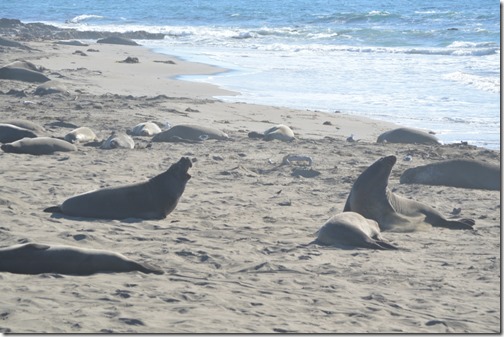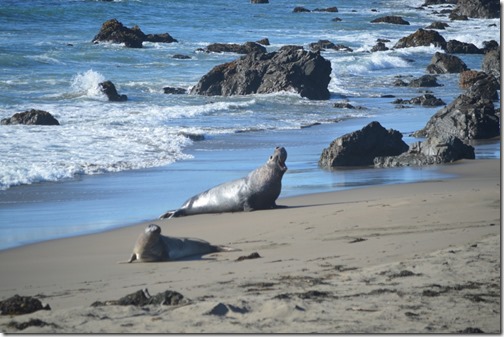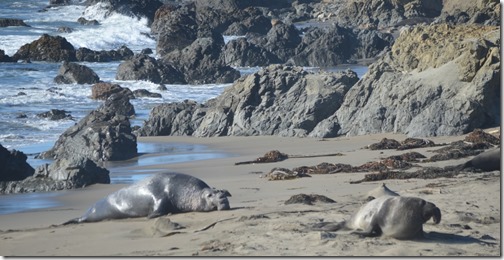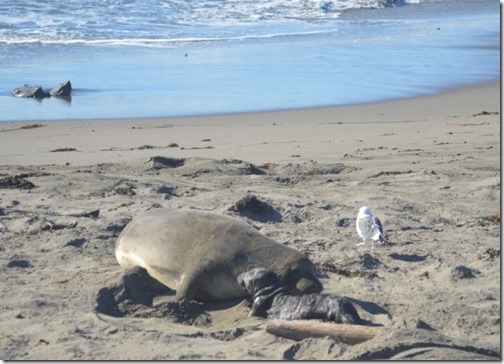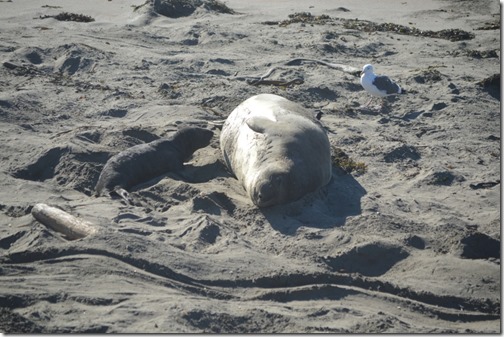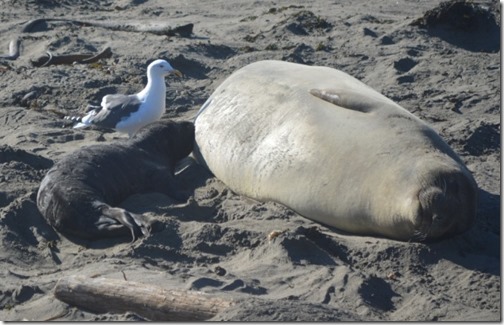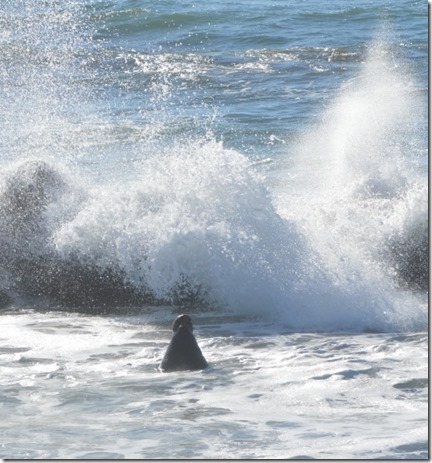An elephant seal rookery is located about 85 miles south of Monterey and 50 miles north of San Luis Obispo on Highway 1, the coast road of Big Sur. This is probably the most accessible spot in California to see elephant seals. The elephant seal viewing area is located directly off Highway 1 south of the Piedras Blancas lighthouse and about four miles north of Heart Castle State Park. Road signs indicate the location.
Elephant seals have returned to the beach at Piedras Blancas this month for the sparring between males, mating between the dominant males and females and birthing season. This is all visible from an elevated walkway on the beach separating visitors from the elephant seals.
Northern elephant seals spend most of their year as solitary creatures migrating around the ocean of the Aleutian Islands of Alaska feeding on deep sea squid and fish. They only come on land twice a year for the breeding season from December to March and a few weeks for the molting season April-May (females) and July-August (males). Females spend about ten months in the sea and males about eight to nine months. Elephant seals can dive for up to an hour at depths of 1,000 to 3,000 feet. They spend 90% of their time at sea underwater.
Northern elephant seals mostly sleeping at Piedras Blancas beach.
There seemed to be very little happening on the beach when I arrived at Piedras Blancas. Most of the elephant seals were simply sleeping on the beach. Elephant seals do not feed during the breeding season and rely on metabolized blubber for their energy. As visible from the photo, most of the elephant seals are conserving their energy for the weeks and months out of the ocean.
The northern elephant seal is a massive mammal. Adult females weigh from 900 pounds, up to 1,600 pounds, yet they are dwarfed by the largest bull males who weigh over 3,000 pounds and up to 5,000 pounds. Adult males are 14 to 16 feet in length and adult females are 9 to 12 feet. Males live up to 15 years and females 22 years.
Males battle for dominance and it can be a bloody affair when two car-size animals start colliding. After a few minutes at the beach I heard one male declaring his standing as he threw back his head and vocalized in a loud, deep clicking sound.
Male elephant seal vocalizing.
Within a few minutes the vocal elephant seal was connfronted by a challenger.
Male elephant seal shouting match on the beach.
The original vocal male (on right) decided flight was the better alternative to fight when challenged and he retreated into the water before contact. The elephant seal who had moved about 20 feet across the sand to challenge the vocal male settled into the spot where the fleeing rival had been.
About 15 minutes later the defeated male came out of the water on another section of beach 50 yards away and started vocalizing again.
Within a few minutes he was challenged by another male and he made another retreat. He certainly had spirit to be a dominant male, if not the strength and courage to stand his ground.
Elephant seals earn their name from the male’s large proboscis appendage. A large nose, large body size and deep vocalization are favorable sexual characteristics. The male on the left was the defeated male from before and he was pushed back to the water again by the male on the right.
Apparently these battles for dominance on the beach last for weeks or months from December into February until the dominant males have established their hierarchy and acquire a harem of females for mating. An alpha male can have 10 to 50 females he protects from other rival males.
Too Cute!
I thought I had seen most of the beach action when I noticed a newborn pup.
The pup was making a similar vocalization as the sparring males, yet it was a higher-pitch squeaky sound.
Like a crying baby, the pup kept vocalizing until mom finally rolled over to allow the pup access to the feeding zone.
Female elephant seals feeding newborn pups lose over one-third of their body weight during the month on the beach while feeding the pup to about 300 pounds before heading back to sea. Females have one pup and this mom will be ready to mate again in about one month. Females are pregnant for about 11 months, yet the gestation period is delayed for a few months while she regains body weight at sea after her time birthing, feeding and weaning her pup on the beach.
Newborn elephant seals weigh 60 to 80 pounds and are about 3 to 4 feet long. It is estimated only about 1 in 6 pups live to 4 years of age. Orca killer whales and great white sharks are primary predators. Apparently the elephant seal is a solitary creature at sea and although the pup is likely to return to this same beach next year, there appears to be no recognition between moms and their pups later in life.
Opportunistic seagull waiting for spilled milk.
December to February is the best season to visit the elephant seal rookery at Piedras Blancas. Sparring, birthing and mating are events to witness in one of the few places where northern elephant seals are easily visible in California.
And maybe this vocal male, the same elephant seal who was smacked down twice during the time I was present at the beach, will eventually find someone to love.
Elephant Seal facts in this article are from Friends of the Elephant Seal website.
*****
Ric Garrido of Monterey, California is writer and owner of Loyalty Traveler.
Loyalty Traveler shares news and views on hotels, hotel loyalty programs and vacation destinations for frequent guests.
Follow Loyalty Traveler on Twitter and Facebook and RSS feed or subscribe to a daily email newsletter of Loyalty Traveler blog posts.






